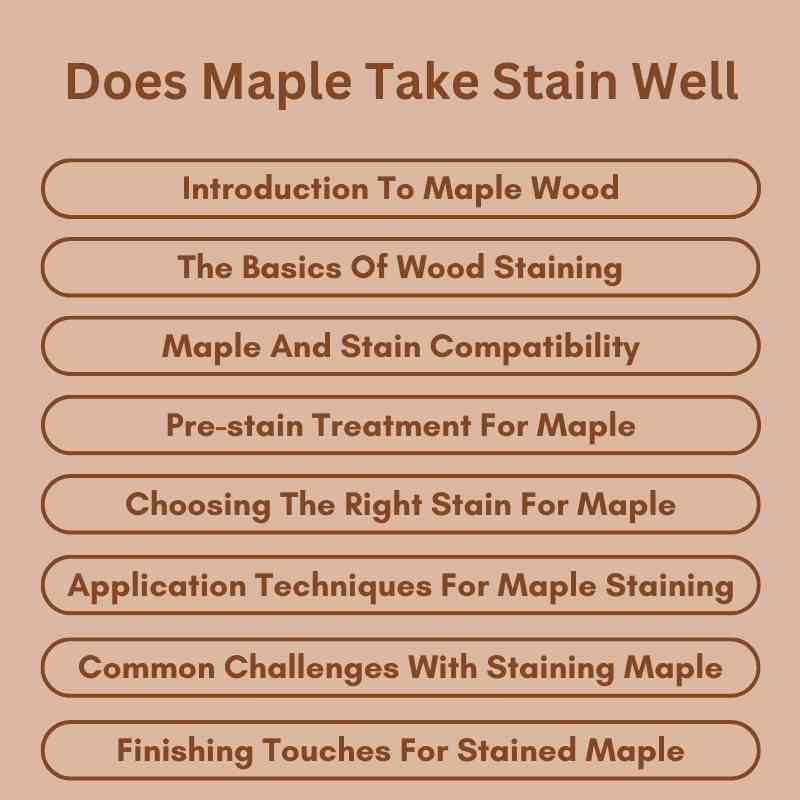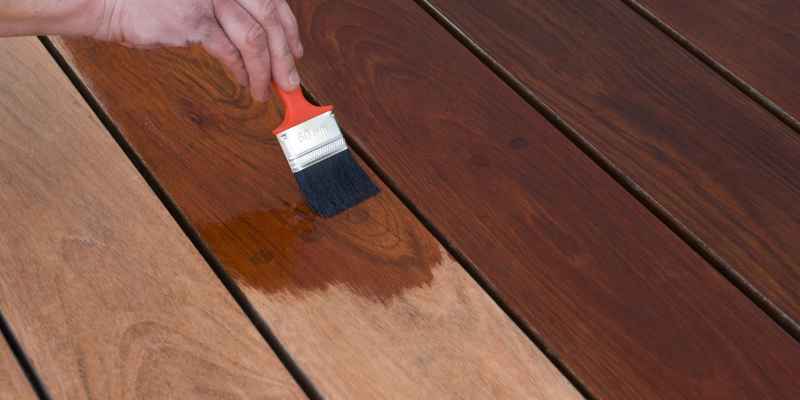Maple wood does take stain well, but it can be challenging to achieve an even finish. Proper preparation and technique are crucial for the best results.
Maple is a popular choice for furniture and cabinetry due to its fine grain and durability. Staining maple can enhance its natural beauty and create a polished look. However, this hardwood’s density and tight grain can sometimes lead to uneven staining.
Understanding the characteristics of maple is essential for successful staining. Prepping the wood correctly and using the right stain can make a significant difference. Many woodworkers and DIY enthusiasts appreciate maple for its versatility and ability to accept various finishes. This blog will explore the best practices for staining maple, ensuring you achieve a stunning result every time.
Introduction To Maple Wood
Maple wood is known for its beautiful grain and durability. It comes in two main types: hard maple and soft maple. Hard maple is stronger and denser. Soft maple is lighter and more flexible.
Maple has a smooth surface, making it ideal for finishing. It accepts stains and paints well. The wood can take on various colors, enhancing its appeal.
Common uses of maple in woodworking include:
- Furniture: Tables, chairs, and cabinets.
- Flooring: Durable and attractive flooring options.
- Musical Instruments: Used for pianos and drum shells.
- Kitchenware: Cutting boards and utensils.

The Basics Of Wood Staining
The purpose of staining wood is to enhance its appearance. Staining can protect wood from damage. It also adds color and depth to the grain. A good stain makes wood look beautiful.
Several factors affect wood stain penetration. The type of wood plays a big role. Some woods, like maple, absorb stain better than others. Grain patterns and wood density also matter. The moisture content in the wood influences stain absorption. Finally, the stain type and application method impact the results.
Maple And Stain Compatibility
Maple wood is popular for its beautiful look. It comes in two types: hard maple and soft maple. Both have different stain compatibility.
Hard maple has a dense grain. This makes it harder to stain evenly. It often requires a pre-stain conditioner for better results.
Soft maple is more absorbent. It stains more easily and shows colors well. The grain structure helps it take stain evenly.
| Type of Maple | Stain Compatibility |
|---|---|
| Hard Maple | Needs conditioner; can blotch |
| Soft Maple | Absorbs well; even staining |
Pre-stain Treatment For Maple
Preparing maple wood is key for great staining results. Proper wood preparation ensures even absorption of the stain. Clean the surface to remove dirt and oils. Sanding the wood helps to create a smoother surface. Use a fine-grit sandpaper for the best results.
Choosing the right pre-stain products is essential. Look for products that enhance wood grain. Wood conditioners are popular choices. They help the stain to penetrate evenly. Test the product on a small area first.
| Pre-Stain Product | Benefits |
|---|---|
| Wood Conditioner | Promotes even stain absorption |
| Sealer | Protects wood and enhances color |
| Stain Blocker | Prevents blotching on soft woods |
Choosing The Right Stain For Maple
Choosing the right stain for maple is important. Oil-based stains penetrate deeply. They enhance the wood’s natural grain. Water-based stains dry quickly. They offer a more eco-friendly option.
Color considerations for maple are crucial. Maple tends to absorb stains unevenly. Lighter stains show the wood’s beauty well. Darker stains can hide the grain. Test a small area before staining.
| Stain Type | Advantages | Disadvantages |
|---|---|---|
| Oil-Based | Deep penetration, rich color | Longer drying time, strong odor |
| Water-Based | Quick drying, low odor | May raise the grain, less depth |
Application Techniques For Maple Staining
Maple wood can absorb stains well with proper techniques. Brushing helps apply stain evenly. It covers surfaces thoroughly. Use a high-quality brush for best results. Make sure to brush in the direction of the grain.
Wiping is another method that works well. This technique allows for easy control of the stain. It helps avoid streaks and puddles. Use a clean, soft cloth for wiping. This method is great for small areas.
To achieve an even stain application, follow these tips:
- Always sand the wood before staining.
- Apply a pre-stain conditioner for even color.
- Work in small sections to prevent drying.
- Wipe off excess stain quickly to avoid blotches.
Common Challenges With Staining Maple
Staining maple can be tricky due to its porous nature. Blotching often occurs, making the finish uneven. To prevent this, start with a wood conditioner. This product helps to even out absorption before staining.
Another method is to test the stain on a scrap piece of maple. This allows you to see how the wood reacts. Using a lighter stain can also help avoid blotching. It gives a more uniform look.
For dealing with uneven absorption, consider applying the stain in thin layers. This technique allows for better control. Always wipe off excess stain quickly. This helps to achieve a smooth finish.
Finishing Touches For Stained Maple
Stained maple can look stunning with the right top coats and sealers. These products help protect the wood. They enhance the color and finish of stained maple. Choose a high-quality sealer for the best results. Oil-based sealers work well for durability.
Regular maintenance keeps stained maple surfaces looking great. Clean them with a soft cloth and mild soap. Avoid harsh chemicals that can damage the finish. Reseal the surface every few years. This ensures long-lasting beauty and protection.
Expert Tips For Best Results
Maple wood can take stain very well. Using the right technique is key. Start with a good sanding to prepare the surface. This helps the wood absorb the stain evenly.
Professional woodworkers suggest stain layering for deeper colors. Apply one layer, let it dry, then add another. This method gives a rich finish.
Custom techniques can also enhance the look. Try using gel stains for better control. They sit on the surface and can create a beautiful finish.
Always test the stain on a scrap piece first. This way, you can see the final color. Different types of maple may react differently to stains.
Real-life Examples Of Stained Maple Projects
Many craftsmen enjoy working with maple. This wood takes stain very well. It shows off beautiful colors and patterns. Users love how stained maple looks in their homes. Stained maple furniture adds warmth and character to any room.
Craftsmen report that staining enhances the natural grain of maple. They appreciate the smooth finish that stains provide. Users often mention the durability of stained maple furniture. It resists wear and tear quite effectively.
| Project Type | User Feedback |
|---|---|
| Coffee Table | Stunning color, very durable. |
| Dining Chairs | Comfortable and easy to clean. |
| Bookshelf | Beautiful finish, holds up well. |

Frequently Asked Questions
Does Maple Wood Absorb Stain Well?
Yes, maple wood can absorb stain effectively. However, its dense grain may lead to uneven results. To achieve a consistent finish, pre-staining with a wood conditioner is recommended. This helps the stain penetrate evenly, enhancing the wood’s natural beauty. Always test a small area first for best results.
What Type Of Stain Is Best For Maple?
Oil-based stains are generally best for maple wood. They penetrate deeply and provide a rich color. Water-based stains can also work but may not offer the same depth. For a more natural look, consider transparent or semi-transparent stains. Always choose high-quality products for optimal results.
How To Prepare Maple For Staining?
Start by sanding the maple surface with fine-grit sandpaper. This removes imperfections and opens the wood grain. Next, clean the dust thoroughly before applying any stain. A wood conditioner can help achieve a more even stain application. Proper preparation ensures a beautiful, lasting finish.
Can I Stain Maple Without Sanding?
While it’s possible to stain maple without sanding, it’s not recommended. Sanding prepares the surface by removing old finishes and allowing better stain absorption. Skipping this step can result in an uneven finish. For the best results, always sand and clean the surface before staining.
Conclusion
Maple wood can indeed take stain well, enhancing its natural beauty. Choosing the right stain and preparation method is crucial. Test samples before committing to a final color. With proper care, stained maple can elevate any project, adding warmth and richness to your space.
Embrace the versatility of this stunning wood!

